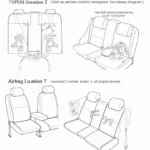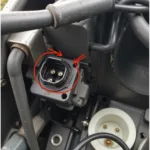Knowing how to reset your OBD2 scanner can be a lifesaver – literally, in some cases! Whether you’re staring down a dreaded Check Engine Light or just finished some DIY repairs, understanding the ins and outs of an OBD2 reset is essential knowledge for any car owner. This guide will walk you through the why, when, and how of OBD2 resets, empowering you to take control of your vehicle’s diagnostics.
What Does Resetting Your OBD2 Scanner Actually Do?
Before we dive into the how-to, let’s clarify what an OBD2 reset actually accomplishes. Essentially, it’s like hitting the refresh button on your car’s computer.
When your car’s onboard computer, the Engine Control Unit (ECU), detects a problem, it logs a Diagnostic Trouble Code (DTC) and often triggers that pesky Check Engine Light. Resetting your OBD2 system clears these codes and turns off the warning light – but here’s the catch: it doesn’t magically fix the underlying issue.
Think of it like clearing a notification on your phone – you’re acknowledging the message, but the problem that caused it might still exist.
When Should You Reset Your OBD2?
There are a few common scenarios where resetting your OBD2 system is appropriate:
- After Completing Repairs: After fixing the issue that triggered the Check Engine Light, resetting allows your ECU to re-evaluate the system and confirm the problem is resolved.
- Intermittent Issues: Sometimes, temporary glitches can trigger false positives. If the Check Engine Light comes on but your car seems to be running fine, a reset can help determine if the issue was transient.
- Before an Emissions Test: In many areas, a glowing Check Engine Light automatically means failing an emissions test. If you’ve addressed any underlying issues, resetting your OBD2 system before the test is essential.
Important Note: It’s crucial to remember that resetting your OBD2 system should never be a substitute for proper diagnosis and repair. If the Check Engine Light persists, it’s a sign that something requires professional attention.
Methods for Resetting Your OBD2 Scanner
There are two primary methods for resetting your OBD2 system:
1. Using an OBD2 Scanner
This is the most reliable and informative method. OBD2 scanners, especially advanced models, provide detailed code definitions, live data streams, and the ability to clear codes directly.
Steps for Resetting with an OBD2 Scanner:
- Locate Your OBD2 Port: It’s typically found under the driver’s side dashboard.
- Connect the Scanner: Plug the scanner into the port and turn your car’s ignition to the “on” position (don’t start the engine).
- Access the “Read Codes” Function: This will display any stored trouble codes.
- Select “Clear Codes” or “Erase DTCs”: Follow the on-screen prompts to clear the codes.
Pro Tip: Consider investing in an OBD2 scanner that offers additional features like live data monitoring, smog check readiness, and manufacturer-specific code definitions. You can find a comprehensive review of top OBD2 scanners on obd2 service reset software.
2. Disconnecting the Battery
This method is less precise and can potentially erase other vehicle settings. However, it’s a viable option if you don’t have an OBD2 scanner on hand.
Steps for Resetting by Disconnecting the Battery:
- Safety First: Disconnect the negative (black) battery terminal first, then the positive (red) terminal.
- Wait: Let the battery disconnect for at least 15-30 minutes. This allows the ECU’s capacitors to discharge.
- Reconnect: Reconnect the positive terminal first, then the negative terminal.
Important Considerations: Disconnecting the battery may reset your radio presets, clock, and other personalized settings. Additionally, this method may not be effective for newer vehicles with more complex computer systems.
Common Questions About OBD2 Resets
Q: Will resetting my OBD2 scanner damage my car?
A: No, resetting your OBD2 scanner itself won’t harm your car. However, it’s crucial to address the underlying issue that triggered the Check Engine Light.
Q: How long does it take for the Check Engine Light to reset itself?
A: In some cases, the Check Engine Light might turn off automatically after a certain number of driving cycles (starting and stopping the engine), especially if the issue was temporary. However, this isn’t a guarantee, and using an OBD2 scanner is the most reliable way to reset the system.
Need More Help?
Knowing how to reset your OBD2 system puts you back in the driver’s seat – literally! You can find more in-depth information on specific OBD2 scanners, including the mbz obd2 air bag scanner gl 550, on our website. If you have any questions or need assistance, don’t hesitate to reach out to our 24/7 customer support team via WhatsApp: +1(641)206-8880 or Email: [email protected].


